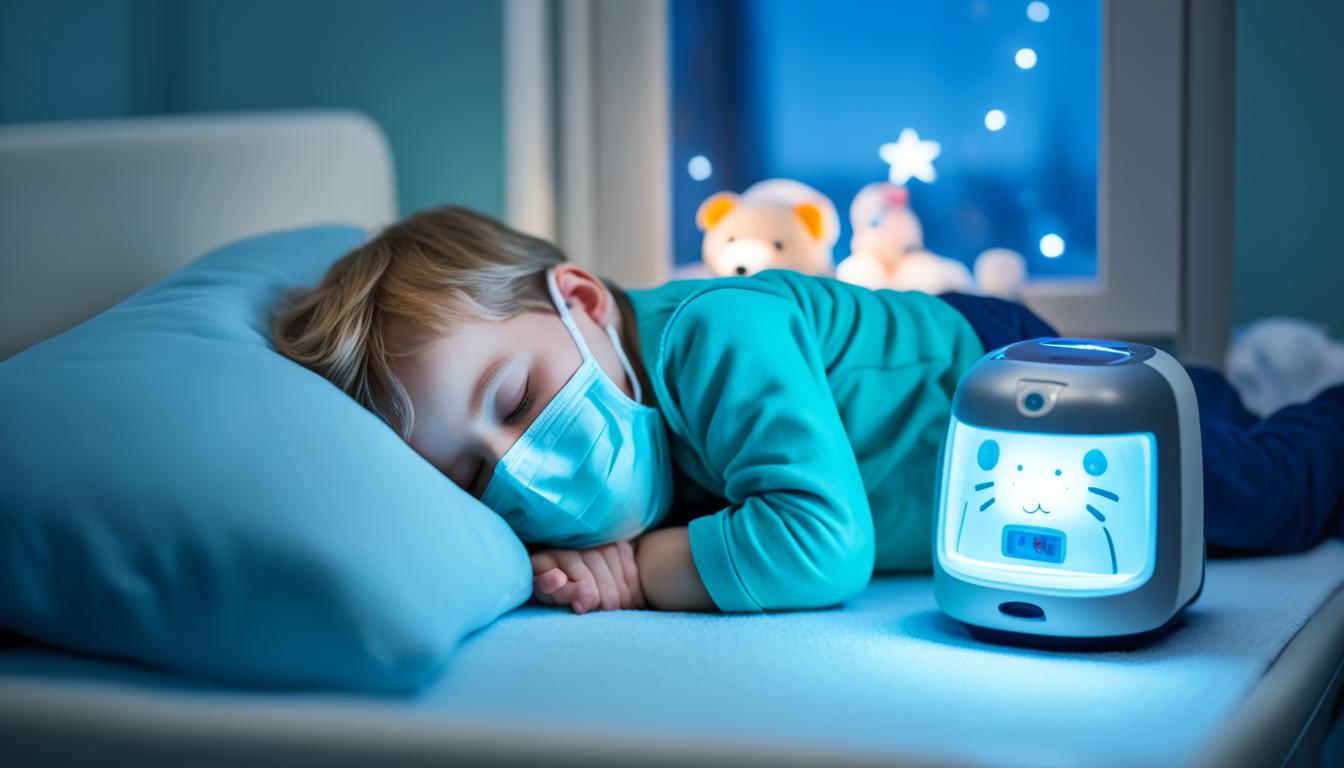Kids with sleep apnea stop breathing for brief times while sleeping. There are two main types: obstructive sleep apnea and central sleep apnea. In obstructive sleep apnea, something blocks the throat or nose. Central apnea happens when the brain doesn’t signal the body to breathe.
If a child snores loud or looks like they’re choking at night, it could be sleep apnea. Other signs are pauses in breathing, breathing through the mouth, sleep terrors, wetting the bed, and odd sleeping positions. Not treating sleep apnea can lead to many health issues, like not doing well in school, heart problems, and obesity.
Enlarged tonsils or adenoids often cause obstructive sleep apnea in children. Certain medical conditions or meds can cause central sleep apnea. Doctors diagnose sleep apnea through tests that check brain waves, breathing, and more.
There are different ways to treat sleep apnea in children. Options include changing the way they live, using nasal steroids, surgery, and even devices to help them breathe better. In the future, stem cell therapy might be a new and helpful treatment for sleep apnea.
Key Takeaways:
- Sleep apnea can be obstructive or central and affects children, too.
- Common symptoms include loud snoring and pauses in breathing at night.
- Left untreated, sleep apnea can cause serious health issues.
- Big tonsils or adenoids often lead to obstructive sleep apnea in kids.
- Diagnosing sleep apnea involves a physical exam and a sleep test.
- There are many options to treat sleep apnea, from surgery to using devices to help breathing.
- Stem cell therapy might become a treatment for sleep apnea in the future.
Causes and Risk Factors
It’s important to know the causes and risks of sleep apnea in children. This helps with early spotting and proper treatment. There are two main types: obstructive (OSA) and central (CSA) sleep apnea.
Enlarged tonsils or adenoids are often the cause of OSA in kids. They block the airway, leading to trouble breathing during sleep. Central sleep apnea can happen due to certain health issues or medications. These affect the part of the brain that controls breathing.
Several things can make children more likely to have sleep apnea. One big risk, especially for OSA, is being overweight. Extra fat around the throat makes the airway narrower. This increases the chances of breathing problems during sleep.
If someone in the family has sleep apnea, a child’s risk goes up too. This hints at a possible link through genes. Conditions like cerebral palsy and Down syndrome also raise OSA risks in kids.
Face or head shapes can also play a role in sleep apnea among children. For example, a big tongue can block the airway. This can cause trouble breathing while sleeping.
African American kids might be more prone to OSA. But, we’re still not sure why this is the case.
Babies born very small or with certain health issues face a higher risk of central apnea. These issues might involve the brain stem, spinal cord, or heart.
Spotting and tackling these causes and risks early is key. It helps improve children’s health and how they enjoy life.
| Type of Sleep Apnea | Main Cause | Key Risk Factors |
|---|---|---|
| Obstructive Sleep Apnea (OSA) | Enlarged tonsils or adenoids | Obesity, family history of sleep apnea, certain medical conditions (cerebral palsy, Down syndrome), abnormalities in the skull or face, large tongue, African American ethnicity |
| Central Sleep Apnea (CSA) | Medical conditions, medications, congenital anomalies affecting the brain’s respiratory centers | Low birth weight, medical conditions affecting the brain stem, spinal cord, or heart |
Diagnosis and Treatment
Diagnosing sleep apnea in kids involves looking closely at their symptoms. A detailed physical exam is done along with a sleep study. This study checks different things like how the brain is working, breathing, and oxygen levels while the child is sleeping. It helps figure out how serious the sleep apnea is.
Treating sleep apnea in children needs many steps. Changing their lifestyle, like losing weight and keeping a good sleep routine, can help. Using nasal steroids might also reduce stuffiness. Surgery to take out big tonsils or adenoids could be an option. Another way is through a machine that keeps the airway open at night (CPAP) or mouthpieces that help hold the airway open. For some types of sleep apnea, a special machine helps with breathing (NIPPV).
There are many ways to treat sleep apnea, depending on its seriousness and the child’s needs. Doctors will look at the situation closely and then choose the best plan for each child. Right now, we have treatments that work well. But researchers are also studying how stem cells could be used one day to treat sleep apnea. Treating sleep apnea early is important. It can help prevent health problems later and make a big difference in a child’s life.

